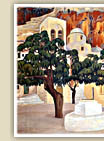
praised both the "lines" and the natural colour of the
Greek landscape. However, the Greek landscape became for Yannopoulos
the tangible proof of the difference between Greeks and barbarians.
The landscape for him is not only the subject of his aesthetics
but also the basis of his theoretical beliefs.
The apotheosis of Greek sunlight and landscape in painting.
In the first two decades of the twentieth century a clear shift
took place from the anthropocentric approach of the previous period
to the discovery, or the cult, of Greek nature.
|
 |

The foundations of Greek landscape painting
were laid in this period, with the emergence and the first works of the prominent
Greek painters, Konstantinos Parthenis, Konstantinos Maleas, and also others
such as Stellios Miliadis, Michalis Oikonomou and Nikolaos Lytras.
The city in the prose.
From the beginning of the century, prose writing focused on the
life of the city. A transition is marked from the open space of
the countryside, which characterized the short story of folkloric
realism (ethography) to the milieu of the city neighbourhood, which
prevailed in the bourgeois short story and novel. This latter trend,
the dominant prose genre, adjusted to the atmosphere of the capital,
following population movements.
|
 |
